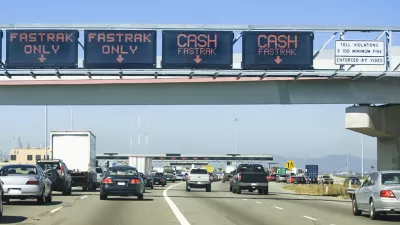A Washington Post/ABC News poll released Jan. 17 showed the exact opposite result of a Reuters/Ipsos poll released two days later on the financing for President Trump's $1 trillion infrastructure plan. However, the polls took different approaches.

The headline of The Washington Post article, "Most Americans don’t want new tolls to pay for road and bridge improvements, poll says," only asked one question on infrastructure.
The poll, conducted by telephone Jan. 12-15, 2017, asked respondents how they felt about private companies taking tax credits and allowing them to charge tolls in exchange for building roads and bridges. Furthermore, there was only one infrastructure question among the 46 questions that dealt with presidents Trump, Obama and other issues:
There is a proposal to offer nearly 140 billion dollars in tax cuts for private companies if they pay to build new roads, bridges and transportation projects. The companies then could charge tolls for people to use these roads, bridges and transportation. Do you support or oppose this proposal?
More accurate was how reported the finding for The Washington Post:
In [the] Washington Post-ABC News poll, 66 percent of those surveyed said they oppose a plan that would grant close to $140 billion in tax credits to investors who put their money into roads, bridges and transit in return for the right to impose tolls.
Why combine the two issues in one question? Why not ask about either tax credits or tolls?
While details of the infrastructure plan have yet to be released, "prior to the election, Donald J. Trump proposed giving private investors an 82 percent tax credit to put money into projects, credits that theoretically would reduce their need to profit from the investment," write Halsey III and Clement.
But even with tax credit incentives, investors are unlikely to put their money into projects that don’t provide a revenue stream, most likely in the form of tolls on roads and bridges.
====================================================================================================
The Reuters-Ipsos poll, conducted Dec. 16 – Jan. 12, released Jan. 19, took a different approach. Respondents were asked about three alternative options to finance Trump's infrastructure plan:
Do you agree/disagree with the following:
- I am willing to pay higher taxes to help invest in infrastructure in the U.S.
- 39.1% agreed
- 51.4% disagreed
- 9.5% unsure
- It is ok for the federal government to take on more debt to pay for infrastructure improvements
- 32.9% agreed
- 56.1% disagreed
- 11.0% unsure
- I am willing to pay tolls and user-fees to fund infrastructure improvements
- 50.1% agreed
- 41.4% disagreed
- 8.5% unsure
The result of the simpler and more comprehensive Reuters/Ipsos poll is quite clear: When offered three competing options to finance the trillion dollar infrastructure plan, tolls and user fees are most preferred, followed by higher taxes. The least favorite is debt-financing.
Hat tip to AASHTO Journal.
FULL STORY: Dr. Gridlock: Most Americans don’t want new tolls to pay for road and bridge improvements, poll says

Montreal Mall to Become 6,000 Housing Units
Place Versailles will be transformed into a mixed-use complex over the next 25 years.

Planetizen Federal Action Tracker
A weekly monitor of how Trump’s orders and actions are impacting planners and planning in America.

DARTSpace Platform Streamlines Dallas TOD Application Process
The Dallas transit agency hopes a shorter permitting timeline will boost transit-oriented development around rail stations.

Study: 4% of Truckers Lack a Valid Commercial License
Over 56% of inspected trucks had other violations.

Chicago Judge Orders Thousands of Accessible Ped Signals
Only 3% of the city's crossing signals are currently accessible to blind pedestrians.

Philadelphia Swaps Car Lanes for Bikeways in Unanimous Vote
The project will transform one of the handful of streets responsible for 80% of the city’s major crashes.
Urban Design for Planners 1: Software Tools
This six-course series explores essential urban design concepts using open source software and equips planners with the tools they need to participate fully in the urban design process.
Planning for Universal Design
Learn the tools for implementing Universal Design in planning regulations.
City of Mt Shasta
City of Camden Redevelopment Agency
City of Astoria
Transportation Research & Education Center (TREC) at Portland State University
US High Speed Rail Association
City of Camden Redevelopment Agency
Municipality of Princeton (NJ)




























